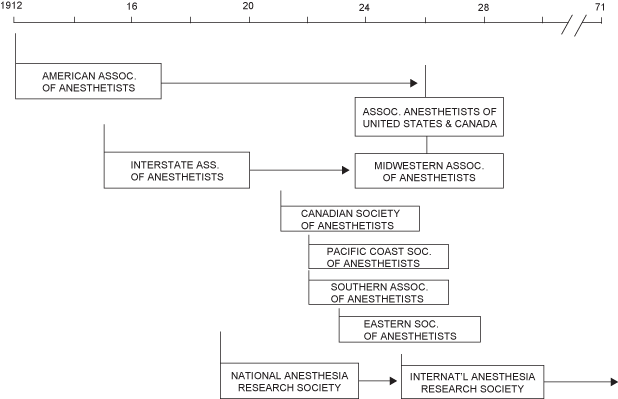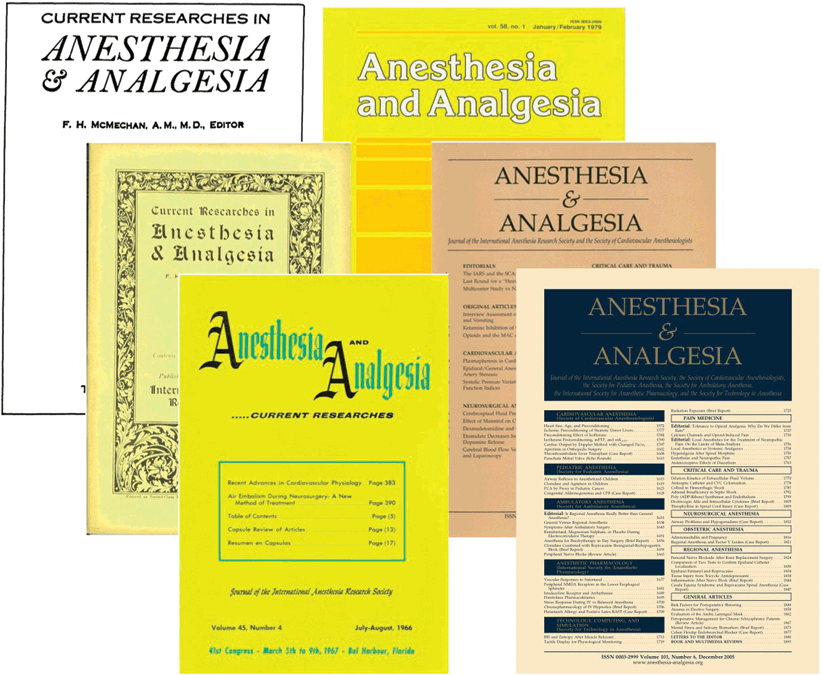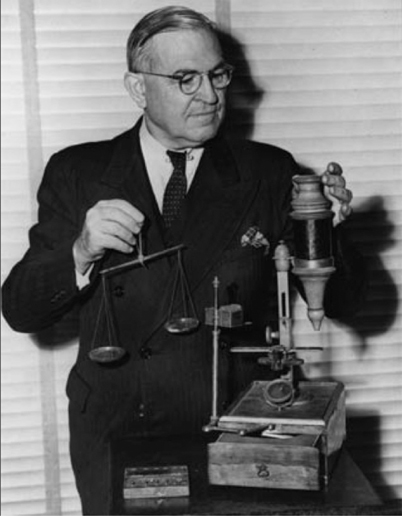Fig. 20.1
Francis McMechan. (Courtesy of the Wood Library-Museum of Anesthesiology, Park Ridge, IL.)
The McMechans
McMechan’s grandfather and father were physicians. While in college, McMechan (1879–1939) won gold medals for oratory and essay writing. He was attracted to dramatics and music. Too young to enter medical school after graduation from college, he worked for 3 years as a playwright, as the Director of the Shuster-Martin School of Acting in Cincinnati [2], and as a reporter for the Cincinnati Post. In 1900, he entered the College of Medicine at the University of Cincinnati. After graduating in 1903, he joined his father’s general practice in Cincinnati. An interest in anesthesia led McMechan to approach surgeons known to his father and ask if he could administer anesthetics for them. They soon appreciated that McMechan possessed unusual skills as an anesthetist, and although he began his career as a general practitioner in Cincinnati, he established a successful anesthetic practice, evolving into one of the first full-time anesthesiologists in the United States [3].
Laurette vanVarseveld McMechan (1878–1970) claimed to be a descendant of Baron Larrey, Napoleon’s Surgeon in Chief. While detailed analysis of historic records does not support this claim, there is no doubt that Laurette had a major positive role in the development of the specialty of anesthesiology, earning the affectionate title “Mother of Anesthetists” [4]. She was a student at the Shuster-Martin School, displaying an interest that coincided with McMechan’s [3]. They married in 1909.
Unfortunately, Francis McMechan developed rapidly progressing rheumatoid arthritis and by the age of 32, his skeletal deformities were so debilitating that he could not continue his medical practice. The disease eventually forced him to sleep while seated and to rely on assistance from others, particularly Laurette. Unable to practice medicine, a tenacious McMechan applied his considerable skills as physician, reporter, playwright and amateur actor, to written communications within the fledgling specialty, and to the development of its organizations. McMechan was the Editor and Executive Secretary of the IARS and had similar appointments in several affiliated organizations. Laurette became his assistant, increasingly assuming responsibilities for the conduct of these organizations as McMechan’s health failed during the late 1930s. She continued with these responsibilities after his death. McMechan spent most of his adult life in a wheelchair, “a device which contained but never confined him” [5]. With the support of his wife and colleagues at the IARS, he remained productive until the late 1930s, traveling throughout the world on behalf of anesthesiology. The following provides the details of his story and the associated history of the IARS.
Formation of the International Anesthesia Research Society (IARS)
The London Society of Anaesthetists (1893), the Long Island Society of Anesthetists (1905) and its successor, the New York Society of Anesthetists (1911) constituted the world of formal organizations in anesthesia at the start of the 20th Century. Formal anesthesia training programs had not been established for physicians1, and no process existed to certify anesthetic practitioners. The specialty was truly in its infancy.
Two parallel streams of anesthesia organizations emerged in the United States. First, the New York Society became the American Society of Anesthetists (1936), to be renamed the American Society of Anesthesiologists (ASA) in 1945. Although the ASA initially included Canadian provinces as components, and one Canadian (Wesley Bourne) served as the ASA President in 1942, this arrangement lapsed and full ASA membership was then restricted to US residents.
Second, McMechan developed competing organizations in the US and Canada, some with international membership categories (Fig. 20.2). The American Association of Anesthetists (AAA, 1912), was linked initially with the American Medical Association, but through McMechan’s influence, soon became fully independent. Additions to the AAA, included state and regional anesthesia societies within the US, and the Canadian Society of Anesthetists. A North American society (Associated Anesthetists of the United States and Canada) succeeded the AAA in 1926. McMechan led the establishment of the National Anesthesia Research Society (NARS) in late 1919. The announcement of the launching of NARS formed part of a report of the 8th Annual Meeting of the American Association of Anesthetists in New Orleans, April 26–27, 1920 [6]. NARS had a mandate to promote research in anesthesiology and to communicate the results of this research, a mandate consistent with McMechan’s vision of the importance of research for the future of anesthesia, and the need to link research with clinical practice. Members included both medical practitioners and industry representatives. However, the inclusion of members from industry prompted controversy and led to the decision to change both the society name and membership eligibility in 1925.

Fig. 20.2
A graphic depiction of the societies McMechan helped create and their approximate creation dates. (From Seldon TH: Anesthesia and analgesia’50 years of publication. Anesth Analg 1971; 50: 571–7, with permission.)
The IARS officially began on the 8th February 1925, by resolution of the “Professional Board of Governors (pro tem)” of the IARS, as the successor of the NARS. The IARS adopted the mission of the NARS, changing only the society name and society membership criteria (by excluding industry representatives). The IARS concurrently became the Publisher ofCurrent Researches in Anesthesia and Analgesia, the first major anesthesia medical journal in the world, a journal started by the NARS in 1922 (Fig. 20.3). The 1925 Constitution and By-Laws of the IARS noted that the Society “…shall have the following Objects: 1) To initiate and foster research in all phases of anesthesia; 2) To establish and maintain the International Research Foundation; and 3) To extend the publication of the literature of anesthesia in so far as its resources may permit and its governing powers may direct” [7]. IARS membership was restricted to physicians, dentists and researchers with advanced degrees. The name change from NARS to IARS followed McMechan’s belief that ‘his’ societies could and should have an international role, as evidenced by the IARS constitution listing its roles as the “official research and publications society of the International Federation of Anesthetists”.

Fig. 20.3
From left to right, covers of 1922, 1926, 1966, 1979, 1994 and 2005 issues ofAnesthesia and Analgesia in various flavors. (FromAnesthesia and Analgesia, with permission.)
The Federation appears, from the limited information now available, to have been an entity under the IARS umbrella which, at various points in time, included anesthesia societies in the United States, Canada and the United Kingdom. For example, the 1930 Directory of Anesthetists (accessed in the Wood Library-Museum of Anesthesiology) lists first the Associated Anesthetists of the United States and Canada, followed by the IARS and eight other societies based in the United States, plus one in Canada and three in the United Kingdom.
McMechan conceived the Federation as an organization that would certify specialists in anesthesia in the United States, Canada and the United Kingdom. However, when the certification process for anesthesia specialists was implemented, it was the International College of Anesthetists (not the Federation) that was the certifying entity. Medical and dental anesthesia specialists received the designation FICA’Fellow of the International College of Anesthetists. The IARS Board of Governors served as the review committee of applications for certification. The 1941 certification requirements included 14 elements, ranging from professional qualifications through clinical anesthesia experience (minimum 2000 cases over 5 years), to IARS membership, and a pledge “to the ethical practice to the specialty of anesthesia”. Applicants were required to “present themselves to the Certification Board for questioning and for receiving certification” [8].
McMechan’s position on certification, as well as his condemnation of non-physician anesthetic practitioners, and those who taught them or worked with them, in part separated his organizations from ASA organizations. When invited in the late 1930s to join the ASA’s collaborative efforts with the AMA in the formation of the American Board of Anesthesiology (ABA), the IARS declined, responding that they already provided certification and that it should be “entirely separate from any other larger medical or surgical organization and free from its domination or control” [9]. Thus, the IARS missed its chance to play a role in the formation of the ABA, and once the ABA was formed, the IARS certification gradually became irrelevant [10]. Newly developed specialty certification processes in Canada and the United Kingdom made the F.I.C.A. qualification irrelevant in those countries as well.
One historical discrepancy remains unresolved. The announcement in the April 1925 issue ofAnesthesia and Analgesia, Current Researches, clearly states 1925 as the official start date for the IARS, succeeding the NARS. However, 1922 (the year of the first journal issue) is the date on the IARS seal. The seal was designed by, or under the authority of, the IARS Board of Governors, so the use of the year 1922 appears deliberate. The records now available do not further explain the seeming discrepancy. The year 1922 continues to be used as the official IARS start date.
Creation and Development of an Independent IARS Journal
McMechan recognized the importance of written communications to the development of anesthesiology. By 1914 he had convinced Joseph MacDonald, Managing Editor of theAmerican Journal of Surgery, to publish aQuarterly Supplement of Anesthesia and Analgesia, with McMechan as editor. The Supplement continued until 1926, despite commencement of publication ofCurrent Researches in Anesthesia and Analgesia in 1922 by NARS, with McMechan as editor. The latter publication coincided with the year in which MacDonald died.2 The Editorial Foreword [11] of the first issue ofCurrent Researches in Anesthesia and Analgesia, in August 1922, included the modest statement: “With this issue the former Bulletin becomes a regular Journal to carry on the organization and educational campaign of the National Anesthesia Research Society. As in the past, the Journal will print papers from the Transactions of the several Associations of Anesthetists, special and selected articles of pertinent interest, as well as abstracts from the current literature of anesthesia and analgesia.” A one-year subscription to the journal cost $ 3.00, and single copies 50 cents.
With formation of the IARS in 1925, the Board of Governors of the IARS became the owners and governing body of the journal. McMechan continued as the Journal’s first editor until his death in 1939. His death precipitated a crisis for the IARS and its Journal, for the IARS Board of Governors had not prepared a succession plan. On 1 July 1939 the Board appointed Board member Emanuel Klaus to the acting positions of Executive Secretary and Editor, and Laurette McMechan as Assistant Executive-Secretary-Editor, the positions she had held before her husband’s death. She continued in these roles until she retired in 1956. Thereafter, she was appointed Honorary Assistant Editor, a position she held until her death in 1970. A published summary of its 24 September 1939 meeting, noted that the Board had considered suggestions that the IARS should “amalgamate with other societies” [12]. In response, the Board approved an amendment to the IARS Constitution and Bylaws, requiring consultation with the membership via a mail vote for any proposal to change the status of the IARS as an organization. A change of IARS status required a two-thirds affirmative vote from at least two-thirds of the members. The IARS Board participated in initial discussions with an ASA committee but then withdrew, ultimately maintaining two societies, two journals (Anesthesiology was not launched until 1940), and two annual meetings [13].
In a further step toward editorial independence for the Journal, unlike two of three prior editors (McMechan and Seldon), Nicholas Greene, appointed as the fourth Editor-in-Chief ofAnesthesia & Analgesia in 1977, declined to serve on the IARS Board of Trustees. This separation of the IARS governing board and the Journal editorial leadership, endured until 2012 when the IARS Board of Trustees (BOT) voted to invite Steven Shafer to participate in all BOT meetings (with certain exceptions) as a guest. This arrangement strengthened the communication between the IARS BOT and the Journal Editor-in-Chief, while maintaining the editorial independence ofAnesthesia & Analgesia.
The history of the Journal, which becameAnesthesia and Analgesia…Current Researches in 1957, andAnesthesia & Analgesia in 1979, may best be appreciated by a review of the contributions of the six Editors who have led it since 1922. In 1971, Seldon chronicled the Journal’s first 50 years [14], and in 1997, Craig and Martin reflected on the first 75 years [5]. We summarize those reviews below and add vignettes for Ronald Miller and Steven Shafer to bring us to 2013.
Francis McMechan (Editor from 1922–1939)
McMechan dominated the early years of the NARS/ IARS and of the Journal (Fig. 20.1). As noted above, he had edited theQuarterly Supplement of Anesthesia and Analgesia of theAmerican Journal of Surgery, from 1914 to 1926. As a former newspaper reporter and playwright he brought effective communication skills to these tasks. Through written communications, in an era when communication tools were basic by modern standards, and by extensive travel during which he promoted the specialty of anesthesiology and “his” societies, McMechan attracted authors, society members and journal subscribers. The Journal was successful and became a vehicle not only for scientific communication, but also for NARS/ IARS announcements. Some of these appear in the indexed pages of the Journal while others are ‘hidden away’ in the annual index, and are not highlighted on the index itself. Commercial advertising was introduced, with a note that “for permanent binding the advertising pages may be withdrawn, without discarding any of the content.” Laurette McMechan held an active position as Assistant Editor and influenced the operations of both the Journal and the various societies. During the 1930s, when chronic illness frequently disabled McMechan, Laurette increasingly assumed governance of Journal operations. This experience proved valuable following McMechan’s death in June 1939. Laurette’s contributions to anesthesia worldwide, including her recognition as the “Mother of Anaesthetists”, were included in tributes published following her death [15].
In 1937 Francis and Laurette were jointly recognized for their many achievements with the presentation of a loving cup trophy with the following inscriptions: “To F. Hoeffer McMechan, M.A., M.D., F.I.C.A. Editor, Secretary-General and Laurette van Varseveld McMechan Associate Editor, Secretary and hostess. In loving appreciation of devoted services and splendid achievements for the organization, economics, research, practice, teaching, journalism and fellowship of the specialty of anesthesia. For the world conquest of human pain in behalf of suffering humanity. Presented by the International Anesthesia Research Society and International College of Anesthetists. Sixteenth annual Congress of Anesthetists. 1937” [16].
Howard Dittrick (1940–1954)
As outlined earlier, the IARS did not have a succession plan ready when McMechan died in 1939. Assisted by Laurette McMechan and the IARS Governors, Emanuel Klaus, a member of the IARS Board of Governors, assumed editorial responsibility for the final three issues of 1939. The January–February 1940 issue announced Dittrick’s appointment as Directing Editor, reporting to the IARS Board (Fig. 20.4) [17]. Dittrick (1877–1954), a gynecologist, had a background in medical editing (Editor of theBulletin of the Cleveland Academy of Medicine) and medical history. His appointment is thought to have been as a result of the IARS Board’s positive view of his academic credentials and international recognition, as well as Dittrick’s longstanding friendships with Klaus and both McMechans [18]. The first Journal issue for 1940 also confirmed the continuing role of Laurette McMechan as Assistant Editor and continued the IARS Board of Governors as the Editorial Board.

Fig. 20.4
Howard Dittrick, second editor ofCurrent Researches in Anesthesia and Analgesia shows one of the many surgical artifacts he collected. (From the Case Western Reserve Dittrick Medical History Center, Cleveland, OH.)
The 1940s were difficult years for the Journal. Dittrick functioned more as a copy editor than an Editor-in-Chief, and had a limited ability to recruit reports for the struggling Journal. Commencing in July 1940, the publication ofAnesthesiology by the American Society of Anesthetists (becoming the American Society of Anesthesiologists in 1945) provided stiff competition forCurrent Researches in Anesthesia and Analgesia. The difficulties created by World War II, including the suspension of the IARS Congresses from 1942 to 1945 (a major source of papers published in the Journal), were also a negative factor. To the credit of the editorial team, the Journal continued bimonthly publication throughout the 1940s, but the numbers of society members and subscribers declined. Dittrick continued as Directing Editor until his death at age 77 early in 1954.
T. Harry Seldon (1954–1976)
After Dittrick’s death, Thomas Harry Seldon, (always addressed as Harry), a member of the IARS Board, assumed the Editor-in-Chief position, in addition to his full time clinical practice as an anesthesiologist at the Mayo Clinic (Fig. 20.5). Laurette McMechan’s appointment as Assistant Editor continued, as did the role of the IARS Board as the Editorial Board of the Journal. Seldon (1905–1991) recognized that the competition provided byAnesthesiology required major changes to the Journal. The official title of the journal was changed in 1957 toAnesthesia and Analgesia…Current Researches. The appearance of the journal changed (Fig. 20.3). The page size was increased, color highlights were added, and new content features were introduced, all to make the Journal more interesting for the reader. These included short notes about new drugs and equipment, historical vignettes and the inclusion of photographs and biographical sketches of first authors. More significant was Seldon’s legendary kindness and patience in helping first authors create publishable articles, through the revision and editing process. The Editorial Board was expanded to include non-IARS Board of Trustee members, a step with symbolic and practical importance. Credited to Harry Seldon, the decline in the status of the Journal was arrested, confidence in it increased [19] andAnesthesia and Analgesia…Current Researches was ready for the next phase.
Stay updated, free articles. Join our Telegram channel

Full access? Get Clinical Tree







